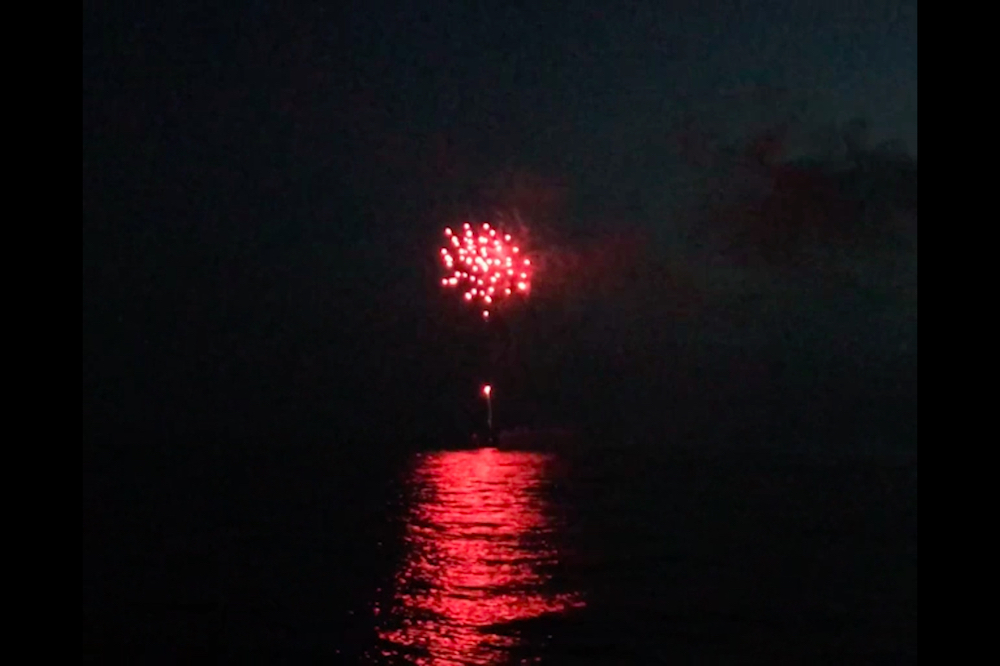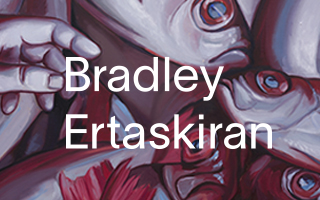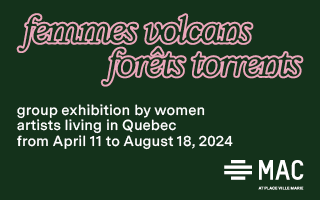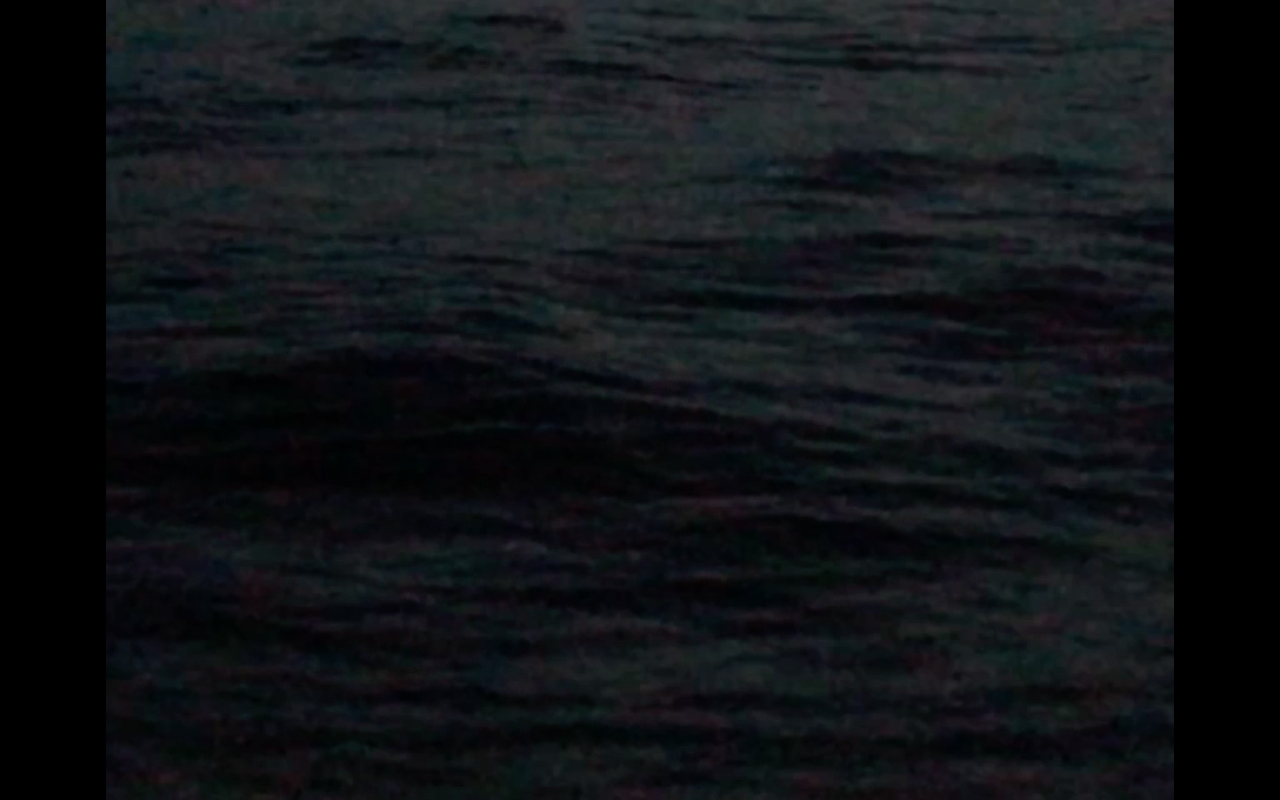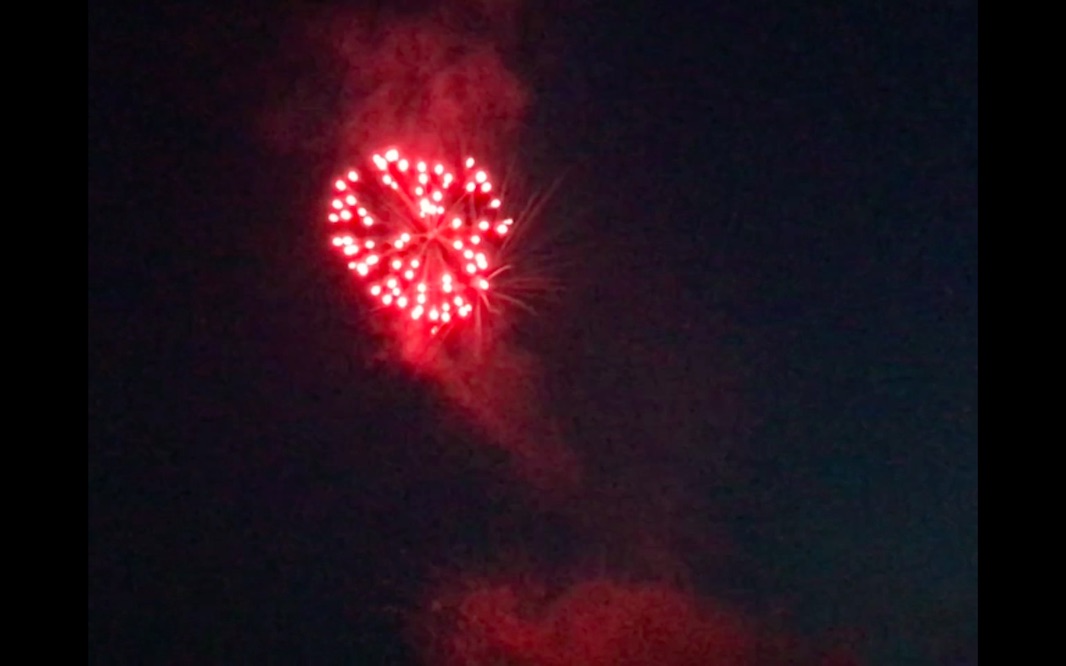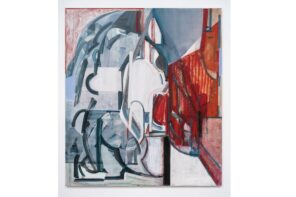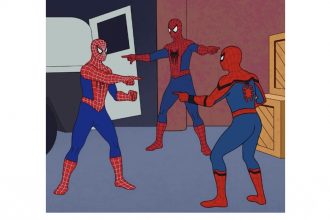The night is dark and full of texture. And somewhere, over an indeterminate stretch of inky sea, the sky is lit up with red sparks. First come the spermlike orbs and wispy smoke trails of distress signals, then exuberant bouquets. I consult a taxonomy of fireworks and am charmed to find they have a kind of botanical poetics to them. Chrysanthemum, dahlia, poinsettia, pistil; willow, palm tree, falling leaves, as well as the rather more prosaic wave, spiral, waterfall. The water is grainy and faintly overshot with a staticky nacre. The horizon bobs unsteadily. We’re on a boat on the open sea, a small one. We could be anywhere, really. Our only coordinates are the shortened link that brought us to this password-protected five-minute Vimeo video, Unititled (fireworks.mov). The access code? “Europe.”
The video, and some accompanying stills, are the only documentation of a clandestine fireworks display from French-Senegalese artist Gusto Zagg. It arrived unsolicited in my inbox, as these things tend to, entirely out of the blue. The performance is either secret or spontaneous, depending on whether you’re reading the promotional PDF or the accompanying publicist email. About that PDF: it’s somewhere between a press release and package holiday brochure, all blown-up full-page stills with overlapping insets and carefully mixed fonts. Perhaps it’s effective branding: you can immediately picture what kind of streetwear this PDF would wear. There’s a rather liberal use of italics in the artist’s bio, which is obscured in places by chopped-up morsels of, presumably, the artist in an artfully bleach-splashed shirt. Violences, complexity of identity, transgression, political messages, societal tensions, traumas, migration, fictional persona.
And yet – some of the photos are quite beautiful. In places where the camera has aggressively zoomed into red noise, the mottled pixels suggest shorn velvet, or a fuzzy peach skin. They encourage a companionable sort of pareidolia where it’s difficult not to pick out faces of people or animals. I think of the soft, blurry carnage of Doom II, and am surprised to be reminded that that videogame’s palette was predominantly brown. But isn’t this aestheticization precisely the problem at hand? That we look but don’t see; that we forget?
Zagg was inspired by maritime distress signals, we learn, to create this “symbolic work,” which aims to draw attention to the Mediterranean crossing of would-be immigrants. It was recorded entirely on an iPhone in a nod to the centrality of smartphones in this newest iteration of refugee flight. Somehow, despite its inherent ephemerality, it’s supposedly related to Land Art too, though the text doesn’t elaborate on this point. I’m reminded of the original publicist email, where Zagg is introduced as an artist and as former assistant to the photographer and filmmaker JR. The aspiration, I imagine, is some kind of steez-by-association, assuming you don’t find JR’s brand of Street Art Bono™ trying. But is this biographic snippet instead intended to reframe the fireworks as the briefest kind of calligraphic gesture, a bit of aerial graffiti that uses light instead of spray paint or smoke?
The video’s ambient soundtrack, which I imagine is titled something like malevolent_soundz.mp3, is “created with exhibition venues in mind.” The project “takes on a singular and political purpose” but also is “not a form of activism” even as it “does circumvent certain regulations in order to illustrate this moment of uncertain transit.” Perhaps this pileup of scare-quotes is unnecessary and I could simply relate that the text is infuriatingly hedge-y and self-contradictory. And perhaps it’s ungenerous to lean so heavily on a work’s accompanying text – these are almost always a little bit tedious. But my experience of this piece is – entirely by design – so remote, so digital, that the PDF feels integral and as much a part of the work as the video itself.
Listen, everything surrounding this project feels obnoxious. Exasperating, even. The overt PR smoke, the password to the video (it’s now freely viewable on a number of hype-culture blogs and magazines, as you might expect). But somehow it works, in a squeaky-wheel-gets-the-grease kind of way. I’m annoyed enough to spend some time updating myself – what an empty phrase to describe an even more empty gesture! – on a refugee crisis that has, like the Somali Civil War or conflicts in Myanmar, Nigeria, Libya, and so many other places, receded into an abstracted background hum. And isn’t that the point? The problem continues, but it no longer dominates the news, especially as you get further from Europe. The topic has become unsexy, the attention economy has moved on.
I am reminded of Carter Ratcliff reviewing the Fourth of July fireworks display in a 1986 Art in America. Despite the unavoidably treacly patriotic symbolism of Independence Day fireworks – freedom, glory, god and country or whatever – he encourages the reader to instead embrace the display as sheer spectacle. That considering pyrotechnics as Color Field painting might be liberating. And he proceeds to do so, to captivating effect:
“As they flowered, the chrysanthemums gave a quick but powerful effect of three-dimensionality. Carrying over to subsequent periods of flatness, memories of this sculptural quality helped the larger bursts to sustain their presence in the airspace above one of the world’s largest natural harbors.”
And,
“Sometimes, as a chrysanthemum-burst faded, as many as half a dozen of its arcs regenerated the form, setting off secondary bursts from their points of furthest extension. When these approached the size of the initial explosion, it was difficult to separate secondary bursts from a new round of primary launches. But overlapping only rarely produced confusion. For the most part, bursts followed in waves whose quick succession served to focus attention and alert the viewer’s eye to nuances of color and intensity.”
There was nothing fancy or particularly remarkable about Zagg’s fireworks. I couldn’t tell you with any reasonable amount of confidence what kind they are, except that they are all the same. Peonies, I think. The video features so many strobing jump cuts that I could well believe it’s a scant handful of shells, 3-7 perhaps, layered over and over again to suggest a longer duration. If anything, the fireworks were attractive precisely because of their simplicity, and perhaps the way they reflected a shining red path on the sea like a molten sunset at midnight.
And there’s something lovely about the idea of a performance with no immediate audience – the way it suggests someone dancing alone for the sheer joy of it. But there’s one line that sticks uncomfortably with me from that original email, like an afterimage or a ringing in the ears. The missive made the claim that the video and photographs are “the only existing images of the happening,” which seems like a wilful misrepresentation. This is not the open ocean but somewhere in the Mediterranean, a body of water that’s not all that big, and filled with people. The issue isn’t a lack of eyes – or surveillance – but rather that people don’t do anything about the things they see. Of course there are more images of the event, captured by weather satellites, nearby cruise ships and fisherpeople, several governments’ tracking systems. Perhaps even some boats of huddled migrants, too.

